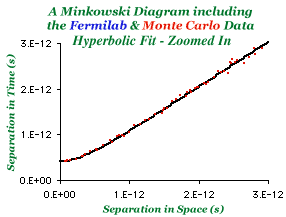What Happens When Things Go Near the Speed of Light?
Advanced Analysis: Deriving the formula for g
Challenge Home -
Online Resources - Challenge - Assessment - Site Index
Look at a different kind of plot.
 The shape of the plot - the best fit is a hyperbola:
The shape of the plot - the best fit is a hyperbola:Did you notice that the axes of the plot are in the same units--seconds!
Seconds are reasonable units for time differences; are they reasonable for distances (space on our plot)? For example, does it make sense to say "The car ride to the concert was 1200 seconds long."? The time "1200 seconds" can describe the distance if you know the rate at which the car travelled. If the car were caught in a traffic jam, the ride would take longer than if there were no traffic. There is ambiguity.
You can remove this ambiguity by agreeing on a common speed. What speed to choose? The air speed velocity of a swallow? Is the swallow African or European? You see the difficulty.
Einstein said that all observers must agree on the speed of light,
regardless of the velocity of the light source. This measurement has been
made several times, using several different techniques, but the result is
always the same: